-
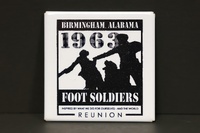 Birmingham, Alabama 1963 Foot Soldiers Reunion, Button.
Birmingham, Alabama 1963 Foot Soldiers Reunion, Button. White square button for the Birmingham, Alabama, 1963 Foot Soldiers Reunion. There is also text on the button that says: "Inspired by what we did for ourselves-and the world." The 1963 Foot Soldiers were children marchers in Birmingham who encountered police resistance in the form of water hoses, attack dogs, and arrests.
-
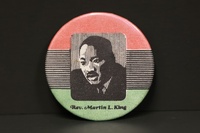 Rev. Martin L. King, Button.
Rev. Martin L. King, Button. A red, green, and black button with an image of Dr. Martin Luther King Jr. Dr. King was a co-founder of the Southern Christian Leadership Conference (SCLC) and remained its leader, and the most prominent leader of the Civil Rights Movement in the South, until his assassination in Memphis in 1968.
-
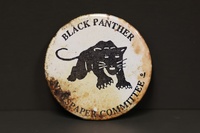 Black Panther Newspaper Committee, Button.
Black Panther Newspaper Committee, Button. A white button with a picture of the Black Panther Party logo. The text says "Black Panther Newspaper Committee." The Black Panther newspaper began as a 4 page newsletter in 1967 by Black Panther Party founders Huey P. Newton and Bobby Seale. The paper went on to express the party’s core ideologies to a large national and international readership.
-
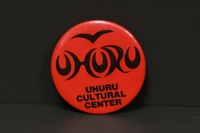 Uhuru Cultural Center, Button.
Uhuru Cultural Center, Button. A red button with the logo for the Uhuru Cultural Center. The Uhuru Movement (from the Swahili word for Freedom”) is an African Internationalist movement founded in 1972 by the African People's Socialist Party (APSP). Uhuru cultural centers and art centers were established around the country.
-
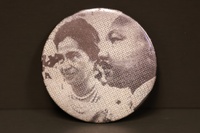 Martin Luther King Jr. With Coretta Scott, Button.
Martin Luther King Jr. With Coretta Scott, Button. A button with a black and white photo of Dr. Martin Luther King Jr. and Coretta Scott. They were married in 1953 until Dr. King’s assassination in 1968. Both were prominent leaders in the Civil Rights Movement in the South. Dr. King was a co-founder of the Southern Christian Leadership Conference (SCLC) and remained its leader until his death.
-
 I Love Africa, Button.
I Love Africa, Button. A white button with a drawing of Africa and the text "I Love Africa."
-
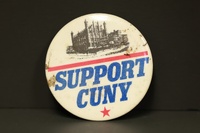 Support CUNY, Button.
Support CUNY, Button. A white button calling for support of CUNY (City University of New York). CUNY was founded in 1960 when several other New York schools were merged into what was initially called the Municipal College System of the City of New York. Throughout the 1960s, CUNY was home to several political and social protests and demonstrations.
-
 John Carlos and Tommy Smith giving the Black Power salute at the 1968 Olympics, Button.
John Carlos and Tommy Smith giving the Black Power salute at the 1968 Olympics, Button. A button with a black and white photo of John Carlos and Tommy Smith giving the Black Power salute at the 1968 Olympics in Mexico City, Mexico after winning bronze and gold medals, respectively, in the 200 meter running event. The salute is considered one of the most overtly political statements in the history of the modern Olympic Games.
-
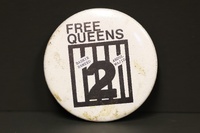 Free Queens 2, Button.
Free Queens 2, Button. A white button in support of freeing the "Queens 2." Their names, Bashir Hameed and Abdul Majid, are listed on the button. The two members of the Black Liberation Army were sentenced to 33 years in prison for the 1981 murder of a New York cop. They were considered political prisoners because of discrepancies in their cases and convictions.
-
 Fannie Lou Hamer, Button.
Fannie Lou Hamer, Button. A red and black button with a picture of Fannie Lou Hamer and her name in print. Ms. Hamer was a renowned leader in Mississippi during the Civil Rights Movement. She worked with the Student Nonviolent Coordinating Committee (SNCC) to organize Freedom Summer in 1964 and was also vice-chair of the Mississippi Freedom Democratic Party.
-
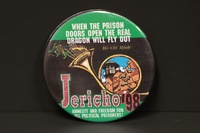 Jericho '98 Amnesty and Freedom for all Political Prisoners, Button.
Jericho '98 Amnesty and Freedom for all Political Prisoners, Button. A black and green button for Jericho '98: Amnesty and freedom for all political prisoners. At the top of the button is a quote from Ho Chi Minh: "When the prison doors open the real dragon will fly out." Jericho 98 was a protest held in Washington, D.C. on March 27, 1998. The 5,000-7,000 attendees called for the release of all political prisoners.
-
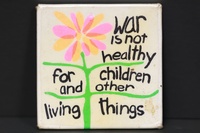 War is Not Healthy for Children and Other Living Things, Button.
War is Not Healthy for Children and Other Living Things, Button. A white square button with a drawing of a flower. The text says: "War is not healthy for children and other living things." The button uses the poster design created by Chicago, Illinois, artist Lorraine Schneider in 1966. The design and slogan became an enduring symbol of the peace movement starting in 1967 with the Vietnam War.
-
 The Million Woman March October 25, 1997. "Celebrating Sisterhood in the spirit of peace, freedom, and justice," Button.
The Million Woman March October 25, 1997. "Celebrating Sisterhood in the spirit of peace, freedom, and justice," Button. A rectangular teal button commemorating the Million Woman March on October 25, 1997. The text says "Celebrating Sisterhood in the spirit of peace, freedom, and justice." The march, which drew over 500,000 attendees to Philadelphia, Pennsylvania, was a grassroots organized event and included demands for improvements to social services and more.
-
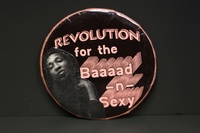 Revolution for the Baaaad -n- Sexy, Button.
Revolution for the Baaaad -n- Sexy, Button. A black and red button with a picture of a woman. The text says: "Revolution for the Baaaad -n- Sexy"
-
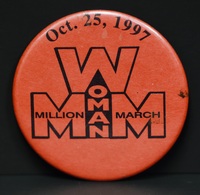 The Million Woman March October 25, 1997, Button.
The Million Woman March October 25, 1997, Button. A red button commemorating the Million Woman March on October 25, 1997. The march, which drew over 500,000 attendees to Philadelphia, Pennsylvania, was a grassroots organized event. The 12 point program of the march included demands for support of imprisoned Black women, improvements to social services, an end to homelessness, and more.
-
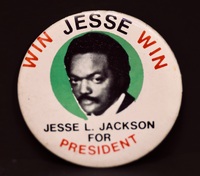 Win Jesse Win, Button.
Win Jesse Win, Button. A white political campaign button in support of Rev. Jesse L. Jackson for president in the 1988 Democratic Party primary. Rev. Jackson more than doubled his vote total from the 1984 race and finished the primary in second place behind eventual Democratic nominee Michael Dukakis.
-
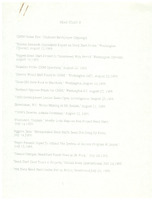 “Head Start B”: A bibliography of sources relating to Child Development Group of Mississippi (CDGM) and Head Start.
“Head Start B”: A bibliography of sources relating to Child Development Group of Mississippi (CDGM) and Head Start. This bibliography lists sources relating to Child Development Group of Mississippi (CDGM) and Head Start. Included are newspaper articles from Mississippi, Washington, D.C., and Virginia.
-
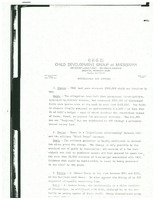 “Accusations and Answers”: A memo from Child Development Group of Mississippi (CDGM) about accusations made against the organization, date unknown.
“Accusations and Answers”: A memo from Child Development Group of Mississippi (CDGM) about accusations made against the organization, date unknown. In this memo from Child Development Group of Mississippi (CDGM), the organization replies to charges made by Senator John Stennis and others. These accusations include an alleged $500,000 financial discrepancy that turned out to be only a $15,000 clerical error. CDGM responds to the charge that the organization has ties with Black Power activists.
-
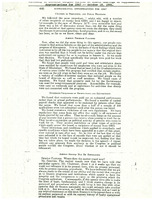 Page 446 of a report on supplemental appropriations by the Office of Economic Opportunity (OEO) for Child Development Group of Mississippi (CDGM), October 18, 1966.
Page 446 of a report on supplemental appropriations by the Office of Economic Opportunity (OEO) for Child Development Group of Mississippi (CDGM), October 18, 1966. In this report on supplemental appropriations by the Office of Economic Opportunity (OEO) for Child Development Group of Mississippi (CDGM), the OEO outlines the decision not to fund CDGM because an investigation showed discrepancies in finances and operating procedures. OEO suggests funding can be regained if CDGM makes operational changes.
-
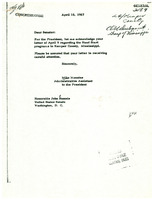 A letter from Mike Manatos, Administrative Assistant to President Lyndon Baines Johnson, to Senator John Stennis about Head Start in Kemper County, Mississippi, April 10, 1967.
A letter from Mike Manatos, Administrative Assistant to President Lyndon Baines Johnson, to Senator John Stennis about Head Start in Kemper County, Mississippi, April 10, 1967. Mike Manatos, Administrative Assistant to President Lyndon Baines Johnson, writes to Senator John Stennis about Head Start in Kemper County, Mississippi. Mr. Manatos writes to acknowledge an April 5th letter from Senator Stennis and assures him the letter is receiving careful attention from the president's office.
-
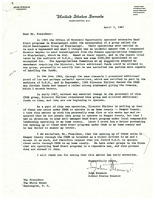 A letter from Senator John Stennis to President Lyndon Baines Johnson about Head Start in Kemper County, Mississippi, April 5, 1967.
A letter from Senator John Stennis to President Lyndon Baines Johnson about Head Start in Kemper County, Mississippi, April 5, 1967. Senator John Stennis writes to President Lyndon Baines Johnson about Head Start in Kemper County, Mississippi. Senator Stennis is requesting that President Johnson forbid the Office of Economic Opportunity (OEO) to operate Head Start units through Child Development Group of Mississippi (CDGM) in his home county.
-
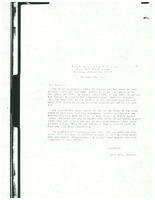 A letter from John Mudd, director of Child Development Group of Mississippi (CDGM) to supporters of CDGM requesting continued support, November 25, 1966.
A letter from John Mudd, director of Child Development Group of Mississippi (CDGM) to supporters of CDGM requesting continued support, November 25, 1966. Director of Child Development Group of Mississippi (CDGM) John Mudd writes this letter to supporters of CDGM requesting continued support in the face of accusations of wrongdoing by the organization. Mr. Mudd lists some of the contributions CDGM and Head Start have made to communities in Mississippi.
-
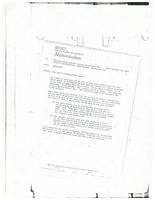 A United States Government Memorandum from Lynn Kirk to The Task Force members working in Central Mississippi, Prairie Opportunities, Hinds County, and Forrest County, November 16, 1966.
A United States Government Memorandum from Lynn Kirk to The Task Force members working in Central Mississippi, Prairie Opportunities, Hinds County, and Forrest County, November 16, 1966. A United States Government Memorandum from Lynn Kirk to The Task Force members working in four different areas of Mississippi with the subject “Head Start funding ground rules.” The memo details how to save money so Head Start can operate with $30 million of a needed $39 million in funding without having to reduce the number of children served.
-
 A letter from John Mudd, director of Child Development Group of Mississippi (CDGM) to supporters seeking input on a new funding proposal.
A letter from John Mudd, director of Child Development Group of Mississippi (CDGM) to supporters seeking input on a new funding proposal. A letter from John Mudd, director of Child Development Group of Mississippi (CDGM) to supporters seeking input on a new funding proposal. The current funding was to expire on September 30, 1966 and CDGM is working to determine how to proceed with acquiring a new round of funding to keep Head Start in Mississippi operating.
-
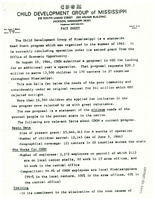 “Fact Sheet”: a memo from Child Development Group of Mississippi (CDGM) outlining the facts about CDGM and Head Start in Mississippi.
“Fact Sheet”: a memo from Child Development Group of Mississippi (CDGM) outlining the facts about CDGM and Head Start in Mississippi. “Fact Sheet”: a memo from Child Development Group of Mississippi (CDGM) outlining the facts about CDGM and Head Start in Mississippi. The memo outlines funding, employees, training programs, committees, councils, board of directors, volunteer work, and statistics about participation in Head Start across the state.
 Birmingham, Alabama 1963 Foot Soldiers Reunion, Button. White square button for the Birmingham, Alabama, 1963 Foot Soldiers Reunion. There is also text on the button that says: "Inspired by what we did for ourselves-and the world." The 1963 Foot Soldiers were children marchers in Birmingham who encountered police resistance in the form of water hoses, attack dogs, and arrests.
Birmingham, Alabama 1963 Foot Soldiers Reunion, Button. White square button for the Birmingham, Alabama, 1963 Foot Soldiers Reunion. There is also text on the button that says: "Inspired by what we did for ourselves-and the world." The 1963 Foot Soldiers were children marchers in Birmingham who encountered police resistance in the form of water hoses, attack dogs, and arrests. Rev. Martin L. King, Button. A red, green, and black button with an image of Dr. Martin Luther King Jr. Dr. King was a co-founder of the Southern Christian Leadership Conference (SCLC) and remained its leader, and the most prominent leader of the Civil Rights Movement in the South, until his assassination in Memphis in 1968.
Rev. Martin L. King, Button. A red, green, and black button with an image of Dr. Martin Luther King Jr. Dr. King was a co-founder of the Southern Christian Leadership Conference (SCLC) and remained its leader, and the most prominent leader of the Civil Rights Movement in the South, until his assassination in Memphis in 1968. Black Panther Newspaper Committee, Button. A white button with a picture of the Black Panther Party logo. The text says "Black Panther Newspaper Committee." The Black Panther newspaper began as a 4 page newsletter in 1967 by Black Panther Party founders Huey P. Newton and Bobby Seale. The paper went on to express the party’s core ideologies to a large national and international readership.
Black Panther Newspaper Committee, Button. A white button with a picture of the Black Panther Party logo. The text says "Black Panther Newspaper Committee." The Black Panther newspaper began as a 4 page newsletter in 1967 by Black Panther Party founders Huey P. Newton and Bobby Seale. The paper went on to express the party’s core ideologies to a large national and international readership. Uhuru Cultural Center, Button. A red button with the logo for the Uhuru Cultural Center. The Uhuru Movement (from the Swahili word for Freedom”) is an African Internationalist movement founded in 1972 by the African People's Socialist Party (APSP). Uhuru cultural centers and art centers were established around the country.
Uhuru Cultural Center, Button. A red button with the logo for the Uhuru Cultural Center. The Uhuru Movement (from the Swahili word for Freedom”) is an African Internationalist movement founded in 1972 by the African People's Socialist Party (APSP). Uhuru cultural centers and art centers were established around the country. Martin Luther King Jr. With Coretta Scott, Button. A button with a black and white photo of Dr. Martin Luther King Jr. and Coretta Scott. They were married in 1953 until Dr. King’s assassination in 1968. Both were prominent leaders in the Civil Rights Movement in the South. Dr. King was a co-founder of the Southern Christian Leadership Conference (SCLC) and remained its leader until his death.
Martin Luther King Jr. With Coretta Scott, Button. A button with a black and white photo of Dr. Martin Luther King Jr. and Coretta Scott. They were married in 1953 until Dr. King’s assassination in 1968. Both were prominent leaders in the Civil Rights Movement in the South. Dr. King was a co-founder of the Southern Christian Leadership Conference (SCLC) and remained its leader until his death. I Love Africa, Button. A white button with a drawing of Africa and the text "I Love Africa."
I Love Africa, Button. A white button with a drawing of Africa and the text "I Love Africa." Support CUNY, Button. A white button calling for support of CUNY (City University of New York). CUNY was founded in 1960 when several other New York schools were merged into what was initially called the Municipal College System of the City of New York. Throughout the 1960s, CUNY was home to several political and social protests and demonstrations.
Support CUNY, Button. A white button calling for support of CUNY (City University of New York). CUNY was founded in 1960 when several other New York schools were merged into what was initially called the Municipal College System of the City of New York. Throughout the 1960s, CUNY was home to several political and social protests and demonstrations. John Carlos and Tommy Smith giving the Black Power salute at the 1968 Olympics, Button. A button with a black and white photo of John Carlos and Tommy Smith giving the Black Power salute at the 1968 Olympics in Mexico City, Mexico after winning bronze and gold medals, respectively, in the 200 meter running event. The salute is considered one of the most overtly political statements in the history of the modern Olympic Games.
John Carlos and Tommy Smith giving the Black Power salute at the 1968 Olympics, Button. A button with a black and white photo of John Carlos and Tommy Smith giving the Black Power salute at the 1968 Olympics in Mexico City, Mexico after winning bronze and gold medals, respectively, in the 200 meter running event. The salute is considered one of the most overtly political statements in the history of the modern Olympic Games. Free Queens 2, Button. A white button in support of freeing the "Queens 2." Their names, Bashir Hameed and Abdul Majid, are listed on the button. The two members of the Black Liberation Army were sentenced to 33 years in prison for the 1981 murder of a New York cop. They were considered political prisoners because of discrepancies in their cases and convictions.
Free Queens 2, Button. A white button in support of freeing the "Queens 2." Their names, Bashir Hameed and Abdul Majid, are listed on the button. The two members of the Black Liberation Army were sentenced to 33 years in prison for the 1981 murder of a New York cop. They were considered political prisoners because of discrepancies in their cases and convictions. Fannie Lou Hamer, Button. A red and black button with a picture of Fannie Lou Hamer and her name in print. Ms. Hamer was a renowned leader in Mississippi during the Civil Rights Movement. She worked with the Student Nonviolent Coordinating Committee (SNCC) to organize Freedom Summer in 1964 and was also vice-chair of the Mississippi Freedom Democratic Party.
Fannie Lou Hamer, Button. A red and black button with a picture of Fannie Lou Hamer and her name in print. Ms. Hamer was a renowned leader in Mississippi during the Civil Rights Movement. She worked with the Student Nonviolent Coordinating Committee (SNCC) to organize Freedom Summer in 1964 and was also vice-chair of the Mississippi Freedom Democratic Party. Jericho '98 Amnesty and Freedom for all Political Prisoners, Button. A black and green button for Jericho '98: Amnesty and freedom for all political prisoners. At the top of the button is a quote from Ho Chi Minh: "When the prison doors open the real dragon will fly out." Jericho 98 was a protest held in Washington, D.C. on March 27, 1998. The 5,000-7,000 attendees called for the release of all political prisoners.
Jericho '98 Amnesty and Freedom for all Political Prisoners, Button. A black and green button for Jericho '98: Amnesty and freedom for all political prisoners. At the top of the button is a quote from Ho Chi Minh: "When the prison doors open the real dragon will fly out." Jericho 98 was a protest held in Washington, D.C. on March 27, 1998. The 5,000-7,000 attendees called for the release of all political prisoners. War is Not Healthy for Children and Other Living Things, Button. A white square button with a drawing of a flower. The text says: "War is not healthy for children and other living things." The button uses the poster design created by Chicago, Illinois, artist Lorraine Schneider in 1966. The design and slogan became an enduring symbol of the peace movement starting in 1967 with the Vietnam War.
War is Not Healthy for Children and Other Living Things, Button. A white square button with a drawing of a flower. The text says: "War is not healthy for children and other living things." The button uses the poster design created by Chicago, Illinois, artist Lorraine Schneider in 1966. The design and slogan became an enduring symbol of the peace movement starting in 1967 with the Vietnam War. The Million Woman March October 25, 1997. "Celebrating Sisterhood in the spirit of peace, freedom, and justice," Button. A rectangular teal button commemorating the Million Woman March on October 25, 1997. The text says "Celebrating Sisterhood in the spirit of peace, freedom, and justice." The march, which drew over 500,000 attendees to Philadelphia, Pennsylvania, was a grassroots organized event and included demands for improvements to social services and more.
The Million Woman March October 25, 1997. "Celebrating Sisterhood in the spirit of peace, freedom, and justice," Button. A rectangular teal button commemorating the Million Woman March on October 25, 1997. The text says "Celebrating Sisterhood in the spirit of peace, freedom, and justice." The march, which drew over 500,000 attendees to Philadelphia, Pennsylvania, was a grassroots organized event and included demands for improvements to social services and more. Revolution for the Baaaad -n- Sexy, Button. A black and red button with a picture of a woman. The text says: "Revolution for the Baaaad -n- Sexy"
Revolution for the Baaaad -n- Sexy, Button. A black and red button with a picture of a woman. The text says: "Revolution for the Baaaad -n- Sexy" The Million Woman March October 25, 1997, Button. A red button commemorating the Million Woman March on October 25, 1997. The march, which drew over 500,000 attendees to Philadelphia, Pennsylvania, was a grassroots organized event. The 12 point program of the march included demands for support of imprisoned Black women, improvements to social services, an end to homelessness, and more.
The Million Woman March October 25, 1997, Button. A red button commemorating the Million Woman March on October 25, 1997. The march, which drew over 500,000 attendees to Philadelphia, Pennsylvania, was a grassroots organized event. The 12 point program of the march included demands for support of imprisoned Black women, improvements to social services, an end to homelessness, and more. Win Jesse Win, Button. A white political campaign button in support of Rev. Jesse L. Jackson for president in the 1988 Democratic Party primary. Rev. Jackson more than doubled his vote total from the 1984 race and finished the primary in second place behind eventual Democratic nominee Michael Dukakis.
Win Jesse Win, Button. A white political campaign button in support of Rev. Jesse L. Jackson for president in the 1988 Democratic Party primary. Rev. Jackson more than doubled his vote total from the 1984 race and finished the primary in second place behind eventual Democratic nominee Michael Dukakis. “Head Start B”: A bibliography of sources relating to Child Development Group of Mississippi (CDGM) and Head Start. This bibliography lists sources relating to Child Development Group of Mississippi (CDGM) and Head Start. Included are newspaper articles from Mississippi, Washington, D.C., and Virginia.
“Head Start B”: A bibliography of sources relating to Child Development Group of Mississippi (CDGM) and Head Start. This bibliography lists sources relating to Child Development Group of Mississippi (CDGM) and Head Start. Included are newspaper articles from Mississippi, Washington, D.C., and Virginia. “Accusations and Answers”: A memo from Child Development Group of Mississippi (CDGM) about accusations made against the organization, date unknown. In this memo from Child Development Group of Mississippi (CDGM), the organization replies to charges made by Senator John Stennis and others. These accusations include an alleged $500,000 financial discrepancy that turned out to be only a $15,000 clerical error. CDGM responds to the charge that the organization has ties with Black Power activists.
“Accusations and Answers”: A memo from Child Development Group of Mississippi (CDGM) about accusations made against the organization, date unknown. In this memo from Child Development Group of Mississippi (CDGM), the organization replies to charges made by Senator John Stennis and others. These accusations include an alleged $500,000 financial discrepancy that turned out to be only a $15,000 clerical error. CDGM responds to the charge that the organization has ties with Black Power activists. Page 446 of a report on supplemental appropriations by the Office of Economic Opportunity (OEO) for Child Development Group of Mississippi (CDGM), October 18, 1966. In this report on supplemental appropriations by the Office of Economic Opportunity (OEO) for Child Development Group of Mississippi (CDGM), the OEO outlines the decision not to fund CDGM because an investigation showed discrepancies in finances and operating procedures. OEO suggests funding can be regained if CDGM makes operational changes.
Page 446 of a report on supplemental appropriations by the Office of Economic Opportunity (OEO) for Child Development Group of Mississippi (CDGM), October 18, 1966. In this report on supplemental appropriations by the Office of Economic Opportunity (OEO) for Child Development Group of Mississippi (CDGM), the OEO outlines the decision not to fund CDGM because an investigation showed discrepancies in finances and operating procedures. OEO suggests funding can be regained if CDGM makes operational changes. A letter from Mike Manatos, Administrative Assistant to President Lyndon Baines Johnson, to Senator John Stennis about Head Start in Kemper County, Mississippi, April 10, 1967. Mike Manatos, Administrative Assistant to President Lyndon Baines Johnson, writes to Senator John Stennis about Head Start in Kemper County, Mississippi. Mr. Manatos writes to acknowledge an April 5th letter from Senator Stennis and assures him the letter is receiving careful attention from the president's office.
A letter from Mike Manatos, Administrative Assistant to President Lyndon Baines Johnson, to Senator John Stennis about Head Start in Kemper County, Mississippi, April 10, 1967. Mike Manatos, Administrative Assistant to President Lyndon Baines Johnson, writes to Senator John Stennis about Head Start in Kemper County, Mississippi. Mr. Manatos writes to acknowledge an April 5th letter from Senator Stennis and assures him the letter is receiving careful attention from the president's office. A letter from Senator John Stennis to President Lyndon Baines Johnson about Head Start in Kemper County, Mississippi, April 5, 1967. Senator John Stennis writes to President Lyndon Baines Johnson about Head Start in Kemper County, Mississippi. Senator Stennis is requesting that President Johnson forbid the Office of Economic Opportunity (OEO) to operate Head Start units through Child Development Group of Mississippi (CDGM) in his home county.
A letter from Senator John Stennis to President Lyndon Baines Johnson about Head Start in Kemper County, Mississippi, April 5, 1967. Senator John Stennis writes to President Lyndon Baines Johnson about Head Start in Kemper County, Mississippi. Senator Stennis is requesting that President Johnson forbid the Office of Economic Opportunity (OEO) to operate Head Start units through Child Development Group of Mississippi (CDGM) in his home county. A letter from John Mudd, director of Child Development Group of Mississippi (CDGM) to supporters of CDGM requesting continued support, November 25, 1966. Director of Child Development Group of Mississippi (CDGM) John Mudd writes this letter to supporters of CDGM requesting continued support in the face of accusations of wrongdoing by the organization. Mr. Mudd lists some of the contributions CDGM and Head Start have made to communities in Mississippi.
A letter from John Mudd, director of Child Development Group of Mississippi (CDGM) to supporters of CDGM requesting continued support, November 25, 1966. Director of Child Development Group of Mississippi (CDGM) John Mudd writes this letter to supporters of CDGM requesting continued support in the face of accusations of wrongdoing by the organization. Mr. Mudd lists some of the contributions CDGM and Head Start have made to communities in Mississippi. A United States Government Memorandum from Lynn Kirk to The Task Force members working in Central Mississippi, Prairie Opportunities, Hinds County, and Forrest County, November 16, 1966. A United States Government Memorandum from Lynn Kirk to The Task Force members working in four different areas of Mississippi with the subject “Head Start funding ground rules.” The memo details how to save money so Head Start can operate with $30 million of a needed $39 million in funding without having to reduce the number of children served.
A United States Government Memorandum from Lynn Kirk to The Task Force members working in Central Mississippi, Prairie Opportunities, Hinds County, and Forrest County, November 16, 1966. A United States Government Memorandum from Lynn Kirk to The Task Force members working in four different areas of Mississippi with the subject “Head Start funding ground rules.” The memo details how to save money so Head Start can operate with $30 million of a needed $39 million in funding without having to reduce the number of children served. A letter from John Mudd, director of Child Development Group of Mississippi (CDGM) to supporters seeking input on a new funding proposal. A letter from John Mudd, director of Child Development Group of Mississippi (CDGM) to supporters seeking input on a new funding proposal. The current funding was to expire on September 30, 1966 and CDGM is working to determine how to proceed with acquiring a new round of funding to keep Head Start in Mississippi operating.
A letter from John Mudd, director of Child Development Group of Mississippi (CDGM) to supporters seeking input on a new funding proposal. A letter from John Mudd, director of Child Development Group of Mississippi (CDGM) to supporters seeking input on a new funding proposal. The current funding was to expire on September 30, 1966 and CDGM is working to determine how to proceed with acquiring a new round of funding to keep Head Start in Mississippi operating. “Fact Sheet”: a memo from Child Development Group of Mississippi (CDGM) outlining the facts about CDGM and Head Start in Mississippi. “Fact Sheet”: a memo from Child Development Group of Mississippi (CDGM) outlining the facts about CDGM and Head Start in Mississippi. The memo outlines funding, employees, training programs, committees, councils, board of directors, volunteer work, and statistics about participation in Head Start across the state.
“Fact Sheet”: a memo from Child Development Group of Mississippi (CDGM) outlining the facts about CDGM and Head Start in Mississippi. “Fact Sheet”: a memo from Child Development Group of Mississippi (CDGM) outlining the facts about CDGM and Head Start in Mississippi. The memo outlines funding, employees, training programs, committees, councils, board of directors, volunteer work, and statistics about participation in Head Start across the state.